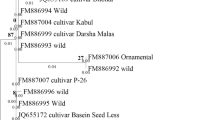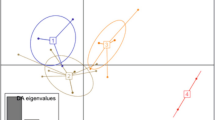Abstract
Key message
The combination of nuclear and chloroplast barcode regions was very effective for distinguishing pomegranate genotypes.
The simultaneous use of molecular, biochemical and morphological markers had a complementary function.
Exclusion of similar genotypes regardless of their geographic region based on different markers helps to reduce the size of the collection, especially when building a core collection is the ultimate goal.
Abstract
Accurate identification of genotypes and their relationships is one of the major challenges in the study of plant taxonomy, especially at the subspecies level. For this purpose, molecular, biochemical, and morphological markers are commonly used in different plant species. In the present study, the sequences of three DNA barcode regions, including the ITS, trnl-F, and matK regions, and all their possible combinations were examined in 21 pomegranate (Punica granatum L.) accessions. In addition, 18 morphological and biochemical characteristics of the genotypes were measured simultaneously to confirm the distinctions. The results show that the combination of three barcode regions (ITS + trnl-F + matK) has the highest efficiency due to the highest number of variable sites as well as parsimony informative sites. Considering the phylogenetic trees obtained from the barcode regions and the morpho-biochemical traits, it can be seen that genotype 808 is clearly different from the other genotypes. Of the genotypes studied in this experiment, ten genotypes were classified into close groups based on their geographic origin in both the barcode and morpho-biochemical clusters. However, genotypes 709, 712, and 708, which were grown in different geographical areas, had similar characteristics, so they were grouped in close branches in both dendrograms. This suggests that the simultaneous use of molecular and morphological markers is essential for distinguishing pomegranate genotypes.




Similar content being viewed by others
Data availability
The data of morpho-biochemical characteristics are included in supplementary Table 1. The nucleotide sequences of three barcode regions were submitted to GenBank (NCBI, USA) and are publicly accessible under the accession numbers ON383940-ON383959 (ITS), ON398439-ON398458 (matK) and ON398459-ON398479 (trnl_F).
References
Ahmed S, Ibrahim M, Nantasenamat C et al (2022) Pragmatic applications and universality of DNA barcoding for substantial organisms at species level: a review to explore a way forward. Biomed Res Int. https://doi.org/10.1155/2022/1846485
Amini F, Saeidi G, Arzani A (2008) Study of genetic diversity in safflower genotypes using agro-morphological traits and RAPD markers. Euphytica 163:21–30. https://doi.org/10.1007/S10681-007-9556-6/METRICS
Aziz S, Firdous S, Rahman H et al (2020) Genetic diversity among wild pomegranate (Punica granatum) in Azad Jammu and Kashmir region of Pakistan. Electron J Biotechnol 46:50–54. https://doi.org/10.1016/J.EJBT.2020.06.002
Badr A, El-Sherif N, Aly S et al (2020) Genetic diversity among selected Medicago sativa cultivars using inter-retrotransposon-amplified polymorphism, chloroplast DNA barcodes and morpho-agronomic trait analyses. Plants 9:1–17. https://doi.org/10.3390/PLANTS9080995
Cabelin VLD, Santor PJS, Alejandro GJD (2015) Evaluation of DNA barcoding efficiency of cpDNA barcodes in selected philippine leea L. (Vitaceae). Acta Bot Gall 162:317–324. https://doi.org/10.1080/12538078.2015.1092393
Chen CW, Huang YM, Kuo LY et al (2013) trnL-F is a powerful marker for DNA identification of field vittarioid gametophytes (Pteridaceae). Ann Bot 111:663–673. https://doi.org/10.1093/AOB/MCT004
Chen Q, Hu H, Zhang D (2022) DNA barcoding and phylogenomic analysis of the genus Fritillaria in China based on complete chloroplast genomes. Front Plant Sci 13:764255. https://doi.org/10.3389/FPLS.2022.764255/FULL
El-Mahdy MT, Youssef M, Elazab DS (2022) In vitro screening for salinity tolerance in pomegranate (Punica granatum L.) by morphological and molecular characterization. Acta Physiol Plant 44:1–11. https://doi.org/10.1007/S11738-022-03361-2/METRICS
Ferrara G, Giancaspro A, Mazzeo A et al (2014) Characterization of pomegranate (Punica granatum L.) genotypes collected in Puglia region, southeastern Italy. Sci Hortic 178:70–78. https://doi.org/10.1016/j.scienta.2014.08.007
Ferrara G, Porfido C, Terzano R et al (2023) A study on the characteristics of buds and flowers in pomegranate: differences among cultivars. Horticulturae 9:117. https://doi.org/10.3390/HORTICULTURAE9010117
Giancaspro A, Mazzeo A, Giove LS et al (2017) Exploiting DNA-based molecular tools to assess genetic diversity in pomegranate (Punica granatum L.) selections and cultivars. Fruits 72:292–305
Gill BA, Musili PM, Kurukura S et al (2019) Plant DNA-barcode library and community phylogeny for a semi-arid east african savanna. Mol Ecol Resour 19:838–846. https://doi.org/10.1111/1755-0998.13001
Hajiyeva SV, Akparov ZI, Hasanov NA et al (2018) ISSR analysis of variability of cultivated form and varieties of pomegranate (Punica granatum L.) from Azerbaijan. Russ J Genet 54:188–197. https://doi.org/10.1134/S1022795418020072/METRICS
Hollingsworth PM, Forrest LL, Spouge JL et al (2009) A DNA barcode for land plants. Proc Natl Acad Sci 106:12794–12797. https://doi.org/10.1073/PNAS.0905845106
Janakiraman N, Narayani M, Johnson M (2022) A review on molecular phylogeny of pteridophytes using DNA barcoding. In: Marimuthu J, Fernández H, Kumar A, Thangaiah S (eds) Ferns. Springer, Singapore, pp 39–58
Jenks AA, Walker JB, Kim SC (2013) Phylogeny of new world Salvia subgenus calosphace (Lamiaceae) based on cpDNA (psbA-trnH) and nrDNA (ITS) sequence data. J Plant Res 126:483–496. https://doi.org/10.1007/S10265-012-0543-1
Jones L, Twyford AD, Ford CR et al (2021) Barcode UK: a complete DNA barcoding resource for the flowering plants and conifers of the United Kingdom. Mol Ecol Resour 21:2050–2062. https://doi.org/10.1111/1755-0998.13388
Liu YC, Lin BY, Lin JY et al (2016) Evaluation of chloroplast DNA markers for intraspecific identification of Phalaenopsis equestris cultivars. Sci Hortic 203:86–94. https://doi.org/10.1016/J.SCIENTA.2016.03.021
Mahadani P, Dasgupta M, Vijayan J et al (2022) DNA barcoding in plants: past, present, and future. Plant genomics sustain Agric. https://doi.org/10.1007/978-981-16-6974-3_13
Maina N, Baraket G, Salhi-Hannachi A, Sakka H (2019) Sequence analysis and molecular evolution of tunisian date palm cultivars (Phoenix dactylifera L.) based on the internal transcribed spacers (ITSs) region of the nuclear ribosomal DNA. Sci Hortic 247:373–379. https://doi.org/10.1016/J.SCIENTA.2018.12.045
Melgarejo-Sánchez P, Núñez-Gómez D, Martínez-Nicolás JJ et al (2021) Pomegranate variety and pomegranate plant part, relevance from bioactive point of view: a review. Bioresour Bioprocess 8:1–29. https://doi.org/10.1186/S40643-020-00351-5
Muraille E (2018) Diversity generator mechanisms are essential components of biological systems: the two queen hypothesis. Front Microbiol 9:1–16. https://doi.org/10.3389/FMICB.2018.00223
Narzary D, Rana TS, Ranade SA (2010) Genetic diversity in inter-simple sequence repeat profiles across natural populations of indian pomegranate (Punica granatum L). Plant Biol 12:806–813. https://doi.org/10.1111/J.1438-8677.2009.00273.X
Ohta T, Dover GA (1984) The cohesive population genetics of molecular drive. Genetics 108:501–521. https://doi.org/10.1093/GENETICS/108.2.501
Padial JM, Miralles A, De la Riva I, Vences M (2010) The integrative future of taxonomy. Front Zool 7:1–14. https://doi.org/10.1186/1742-9994-7-16/TABLES/1
Pakyurek M (2019) Genetic similarity of pomegranate genotypes grown in siirt province. J Biol Agric Healthc 9:14–18. https://doi.org/10.7176/JBAH/9-20-03
Pal P, Ray Banerjee E (2020) Nanoscience and DNA barcoding. In: Ray Banerjee E (ed) Nanomaterials and Biomedicine. Springer, Singapore, pp 127–134
Patil PG, Singh NV, Bohra A et al (2021) Comprehensive characterization and validation of chromosome-specific highly polymorphic SSR markers from pomegranate (Punica granatum L.) cv. Tunisia genome. Front Plant Sci 12:1–12. https://doi.org/10.3389/FPLS.2021.645055/BIBTEX
Ramesh M, Sen A, Vachher M, Nigam A (2022) Delineating bacteria using DNA barcoding. Mol Genet Microbiol Virol 36:65–73. https://doi.org/10.3103/S0891416821050128
Razi S, Soleimani A, Zeinalabedini M et al (2021) Development of a multipurpose core collection of new promising iranian pomegranate (Punica granatum L.) genotypes based on morphological and pomological traits. Horticulturae 7:350. https://doi.org/10.3390/HORTICULTURAE7100350/S1
Richardson JL, Urban MC, Bolnick DI, Skelly DK (2014) Microgeographic adaptation and the spatial scale of evolution. Trends Ecol Evol 29:165–176. https://doi.org/10.1016/J.TREE.2014.01.002
Sevindik E, Efe F (2021) Molecular genetic diversity and phylogenetic analyses of Punica granatum L. populations revealed by ISSR markers and chloroplast (cpDNA) trnL-F region. Erwerbs-Obstbau 63:339–345. https://doi.org/10.1007/S10341-021-00581-7/METRICS
Shekhovtsov SV, Shekhovtsova IN, Peltek SE (2020) DNA barcoding: methods and approaches. Biol Bull Rev 9:475–483. https://doi.org/10.1134/S2079086419060057
Stover E, Mercure EW (2007) The pomegranate: a new look at the fruit of paradise. HortScience 42:1088–1092. https://doi.org/10.21273/HORTSCI.42.5.1088
Tamura K, Peterson D, Peterson N et al (2011) MEGA5: molecular evolutionary genetics analysis using maximum likelihood, evolutionary distance, and maximum parsimony methods. Mol Biol Evol 28:2731–2739. https://doi.org/10.1093/MOLBEV/MSR121
Tapia-Campos E, Del Ramírez-Anaya P, Cavazos-Garduño J A, et al (2021) Morphological characterization of southern Jalisco, Mexico, pomegranate genotypes using AFLP markers. Agronomy 11:1449. https://doi.org/10.3390/AGRONOMY11081449
Tsang S, Sun Z, Stewart C et al (2004) Development of multiplex DNA electronic microarrays using a universal adaptor system for detection of single nucleotide polymorphisms. Biotechniques 36:682–688. https://doi.org/10.2144/04364DD02
Ünsal SG, Çiftçi Y, Eken BU et al (2019) Intraspecific discrimination study of wild cherry populations from North-Western Turkey by DNA barcoding approach. Tree Genet Genomes. https://doi.org/10.1007/S11295-019-1323-Z
Vásquez-Mayorga M, Fuchs EJ, Hernández EJ et al (2017) Molecular characterization and genetic diversity of Jatropha curcas L. Costa Rica PeerJ 5:1–18. https://doi.org/10.7717/PEERJ.2931
Wang M, Zhao H, xia, Wang L et al (2013) Potential use of DNA barcoding for the identification of salvia based on cpDNA and nrDNA sequences. Gene 528:206–215. https://doi.org/10.1016/J.GENE.2013.07.009
Yuan Z, Yin Y, Qu J et al (2008) Population genetic diversity in chinese pomegranate (Punica granatum L.) cultivars revealed by fluorescent-AFLP markers. Elsevier 34:1061–1071. https://doi.org/10.1016/S1673-8527(07)60121-0
Zhang X, Zhao Y, Ren Y et al (2020) Fruit breeding in regard to color and seed hardness: a genomic view from pomegranate. Agronomy 10:991–1017. https://doi.org/10.3390/AGRONOMY10070991
Zhu S, Niu E, Shi A, Mou B (2019) Genetic diversity analysis of olive germplasm (Olea europaea L.) with genotyping-by-sequencing technology. Front Genet 10:755. https://doi.org/10.3389/FGENE.2019.00755/BIBTEX
Funding
This work was supported by Shahrekord University (Grant number 99GRN31M783). Author Mohammad Rabiei has received research support from Shahrekord University.
Author information
Authors and Affiliations
Corresponding author
Ethics declarations
Conflict of interest
The authors have no competing interests to declare that are relevant to the content of this article.
Additional information
Communicated by J. Carlson.
Publisher’s Note
Springer Nature remains neutral with regard to jurisdictional claims in published maps and institutional affiliations.
Supplementary Information
Below is the link to the electronic supplementary material.
Rights and permissions
Springer Nature or its licensor (e.g. a society or other partner) holds exclusive rights to this article under a publishing agreement with the author(s) or other rightsholder(s); author self-archiving of the accepted manuscript version of this article is solely governed by the terms of such publishing agreement and applicable law.
About this article
Cite this article
Moradi Ashour, B., Rabiei, M. & Shiran, B. Intraspecific identification of some pomegranate (Punica granatum L.) genotypes based on DNA barcoding and morpho-biochemical characteristics. Trees 37, 1435–1442 (2023). https://doi.org/10.1007/s00468-023-02434-0
Received:
Accepted:
Published:
Issue Date:
DOI: https://doi.org/10.1007/s00468-023-02434-0




